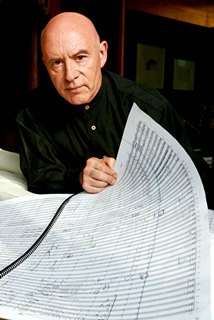|
Back
Vim and Vigor Houston
Jones Hall
04/14/2010 -
Sergei Prokofiev: Symphony No. 1 in D Major, Op. 25, “Classical” – Piano Concerto No. 3 in C Major, Op. 26
Ludwig van Beethoven: Symphony No. 7 in A Major, Op. 92
Lang Lang (piano)
Schleswig-Holstein Festival Orchestra, Christoph Eschenbach (conductor)

C. Eschenbach (© Eric Brissaud)
Christoph Eschenbach made a monumental return to Jones Hall, bringing with him the superstar pianist Lang Lang and the orchestra of the Schleswig-Holstein Festival, one of the world’s most esteemed training grounds for young instrumentalists. Entering the stage to a standing ovation from a nostalgic Houston audience, he brought his ever-intriguing interpretive bent to a fiery trio of masterworks, capitalizing on the energy and flamboyance of his youthful musicians, and delivering an evening that was in turn exhilarating and perplexing.
Throughout the evening, Eschenbach’s tempo choices surprised. The opening movement of the Prokofiev symphony was taken quite a bit slower than the composer’s metronome marking, and if the orchestral response wasn’t as accurate, blithe and exaggerated, the night would have started with a whimper instead of a bang. Fortunately, Eschenbach coaxed rhythmically precise and dynamically larger-than-life contrasts from his players, and the momentum of the opening movement never flagged. The buildup to the recapitulation was especially impressive, and was followed by a nicely sculpted rendition of the Larghetto. Eschenbach’s pushing and pulling of the tempo in the Gavotte verged on artifice, but was saved by the movement’s brevity. The finale was taken at breakneck speed and turned into a miniature concerto for orchestra, the wind players negotiating their challenging solos with élan.
The slow introduction to the Beethoven symphony raised red flags, with Eschenbach choppily segmenting the music into two-bar chunks with exaggerated anacrusis gestures, but once the Vivace began, he was less fussy with the piece. Tempos were more conventional, and his decision to play each movement attaca was effective. There was fine playing from the principal oboist in the first movement, but I wished for more presence (and accuracy) from the horns, though they redeemed themselves in the finale. The Allegretto had the perfect amount of forward motion, the pomposity of the third movement trios was nicely pointed up, and the finale, taken at a nice clip, brought the evening to a great close. As if the orchestra hadn’t shown its prowess in Beethovenian fireworks, they dug in to an exhilarating encore in the form of the composer’s Consecration of the House overture.
This was my first live encounter with the jet-setting celebrity pianist Lang Lang, and I wish I had a more positive reaction to his performance of Prokofiev’s ingenious concerto. He certainly possesses great technical gifts, but his interpretive choices seemed perplexing if not counterintuitive and, for all his grandiose choreography, he produced a rather small, at times hollow sound. The end effect after a first movement Allegro played as quickly as possible, a Theme and Variations unnecessarily heaved and hoed by conductor and pianist, and a finale that ended in an unnecessarily hectic barrage, was of a precocious adolescent more interested in showing off than a mature virtuoso using his technical gifts to probe the music for deeper meaning. Voicing of chords was sporadic, overly accented notes protruded from the texture like barbs, and Prokofiev’s explicit indications in the score, such as the progressive diminuendo leading into the second theme of the first movement, were simply ignored. The textures in the outer movements are so complex and full of rich detailing that the composer’s “ma non troppo” modifier to the finale’s tempo marking needs to be taken to heart, not just for that movement, but for the entire work. Naturally, the audience immediately jumped to their feet after the chord, and their shouts of “Yeehaw!” were rewarded with an equally showy, anything-but-subtle encore in the form of Chopin’s E Major etude (Op. 10/3) that made me immediately long for one of Sviatoslav Richter’s immortal readings of the piece, where supernatural technique is perfectly married to impeccable interpretive acumen.
Marcus Karl Maroney
|